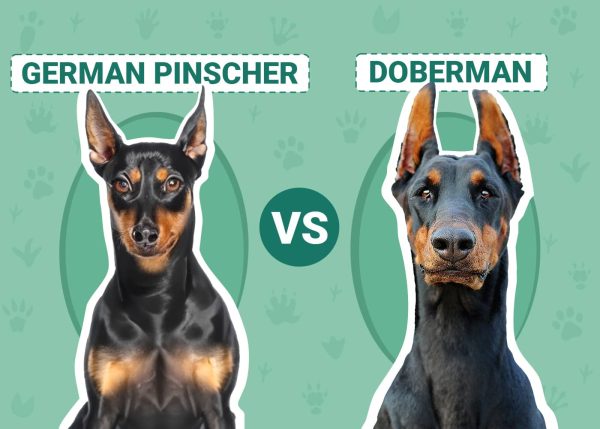Click to Skip Ahead
If you’re unfamiliar with German Pinschers and Dobermans, it can be pretty tricky telling the difference between the two. Both breeds originated in Germany, both are members of the working group, and their body types and coloration are pretty similar. Furthermore, the Doberman actually descends from the German Pinscher.
So, what are the differences between the German Pinscher and the Doberman Pinscher? In this post, we’ll compare the two breeds so you can gain a better understanding of how they’re alike and how they’re different. We hope this will help you decide which breed is right for you.
Visual Differences
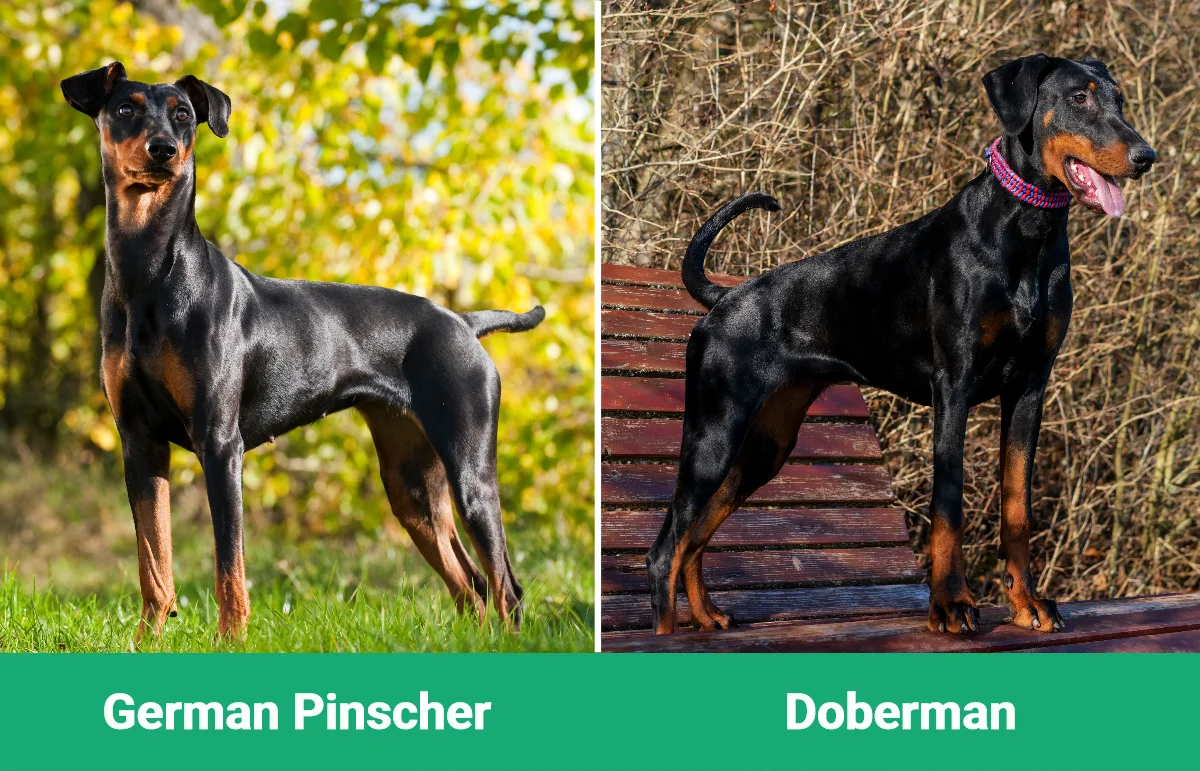
At a Glance
- Average height (adult): 17–20 inches
- Average weight (adult): 24–45 pounds
- Lifespan: 12–14 years
- Exercise: About 2 hours per day
- Grooming needs: Low
- Family-friendly: Often
- Other pet-friendly: Yes, with proper socialization
- Trainability: Intelligent but can be willful—may be best suited to experienced owners
- Average height (adult): 24–28 inches
- Average weight (adult): 60–100 pounds
- Lifespan: 10–12 years
- Exercise: About 2 hours per day
- Grooming needs: Low–Moderate
- Family-friendly: Often
- Other pet-friendly: Yes, with proper socialization
- Trainability: Smart and eager to please but can be bossy
German Pinscher Overview
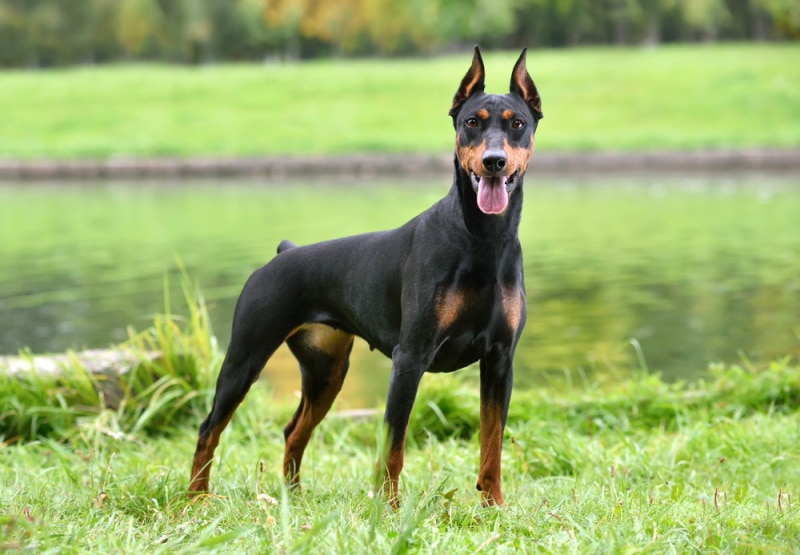
German Pinschers are the descendants of German Bibarhunds and Tanners. They originated in 19th-century Germany and were bred to protect stables and seek out and kill rats. The Pinscher was also one of the foundation breeds for the Miniature Pinscher and Doberman.
Personality
German Pinschers are described by the American Kennel Club as “intelligent”, “courageous”, and “vivacious”. Due to their history as rat hunters, they have natural alertness and excellent watchdog capabilities. This means that they can be somewhat suspicious of strangers. All that said, the German Pinscher is a typically good-natured dog if socialized and trained properly.
With proper socialization, German Pinschers are very family oriented. It’s important that children are taught how to respectfully interact with the German Pinscher.
As for other pets, it’s best to socialize your German Pinscher with them as early as possible since these dogs have a strong prey drive and will need to learn to curb their urges to chase cats and smaller animals.
Appearance
German Pinschers are medium-sized dogs with short, glossy coats that vary in color. AKC standard colors are black, blue, fawn (Isabella), and red and markings can be tan, red, or red and tan. They don’t require much grooming—a weekly brush should do the trick.
They have powerful heads and oval-shaped eyes, and their ears are floppy but sometimes cropped (read more on why cropping a dog’s ears is not a good idea below). Their bodies are elegant and sleek with a “tucked-in” waist. They are smaller and lighter than Dobermans.
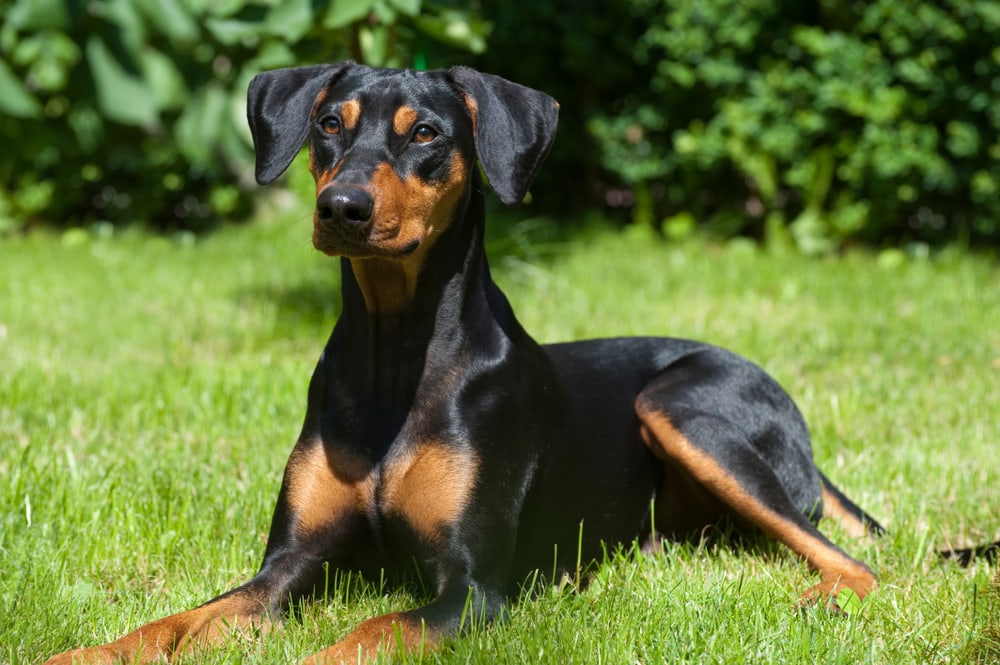
Exercise Needs
The athletic and high-energy German Pinscher needs a good amount of exercise every day to prevent boredom. If you’re looking for a jogging or hiking partner, the German Pinscher is a great choice as they have a love for any kind of physical activity.
Training
German Pinschers are highly intelligent dogs. They respond better to firm but kind and consistent leaders as they have a tendency to be willful and headstrong.
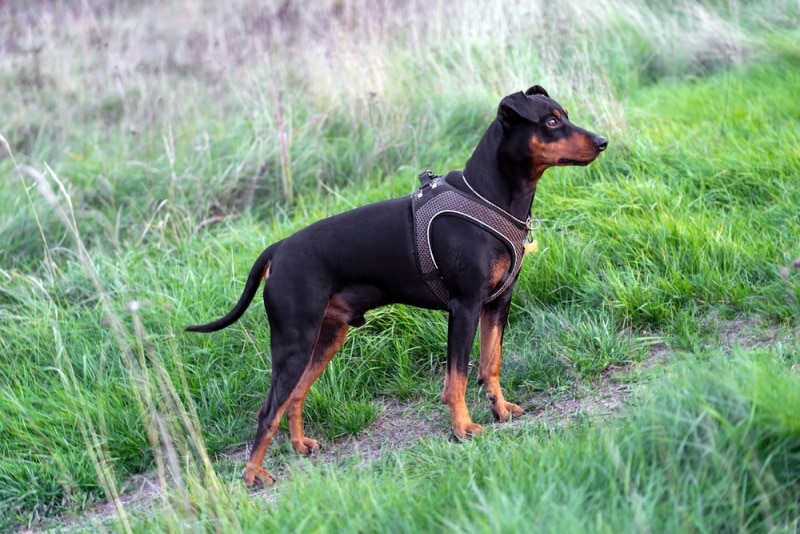
Suitable for:
German Pinschers are best suited to experienced dog owners because, though they’re typically very loving dogs, they can be strong-willed when it comes to training. They would also be suitable for active families that enjoy outdoor pursuits like hiking, jogging, and general adventuring as they love exploring and the challenge of exerting themselves physically.
Doberman Pinscher Overview
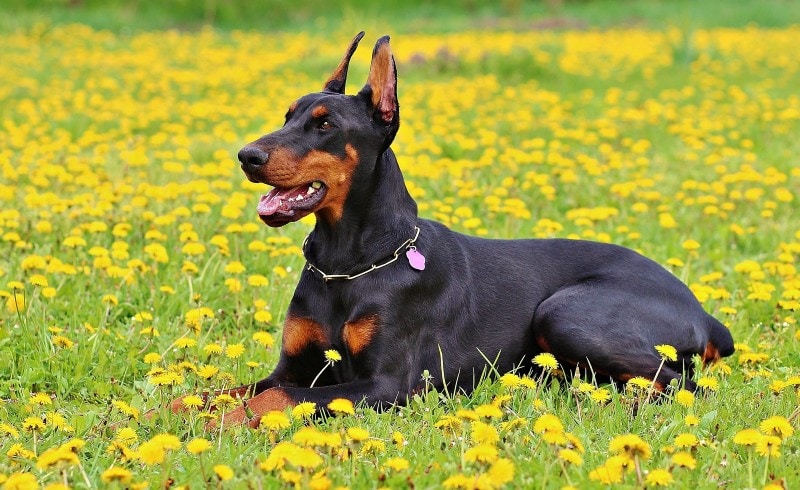
Like the German Pinscher, Doberman Pinschers originated in Germany and date back to the 19th century. They were bred by taxman Louis Dobermann from Apolda to protect him from the citizens he collected taxes from.
Personality
Like the German Pinscher, Dobermans are courageous dogs with natural alertness and a fierce sense of loyalty. They’re often very protective of their humans and make great watchdogs, but their alertness is coupled with a fun-loving streak that makes them a joy to spend time with.
They also tend to be family-oriented and, according to the AKC, are typically very good with young children (with socialization, of course). It’s important to socialize your Doberman with children and other pets from as early an age as possible.
From our research, it seems that Dobermans may be better suited to families with young children than German Pinschers are (this is just a generalization—German Pinschers are also perfectly capable of getting on well with children in the right environment and with socialization!).
Appearance
The Doberman is taller and heavier than the German Pinscher but also has a slender, powerful build with a tucked-in waist.
They have smooth, short coats that need a quick daily brush and come in five colors and color combinations—four of which are standard (black and rust, blue and rust, red and rust, and fawn (Isabella) and rust) and one of which is an alternative color (white). The AKC lists no markings for this breed.
Dobermans have long heads, almond-shaped eyes, and ears that are naturally floppy but often cropped for a “tougher” look. Ear cropping is illegal in some locations including the UK and for good reason—cropping a dog’s ears can affect how dogs communicate, their body language, and possibly even their hearing.
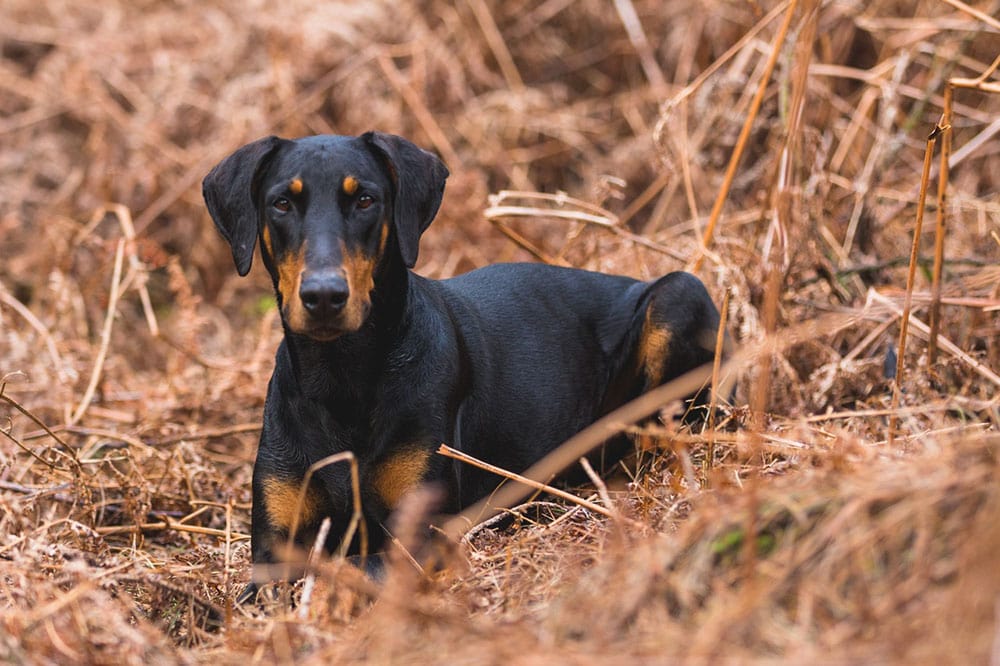
Exercise Needs
A very energetic and agile breed, the Doberman needs plenty of exercise in the form of daily walks, jogs, and/or play. It’s also recommended to have a spacious fenced-off area for your Doberman to let off steam when they need to.
Training
Dobermans are very smart, eager to please, and generally don’t find it difficult to learn what’s expected of them. Like German Pinschers, they need early socialization and firm but kind leadership as they can be bossy and even destructive without a capable “pack” leader (you) to show them the way.
Suitable for:
Doberman Pinschers are a good choice for loving, active families that will give them all the attention they need and spend time properly socializing them. They would also be well-suited to people with a yard or fenced-off outdoor area for extra exercise and mental stimulation.
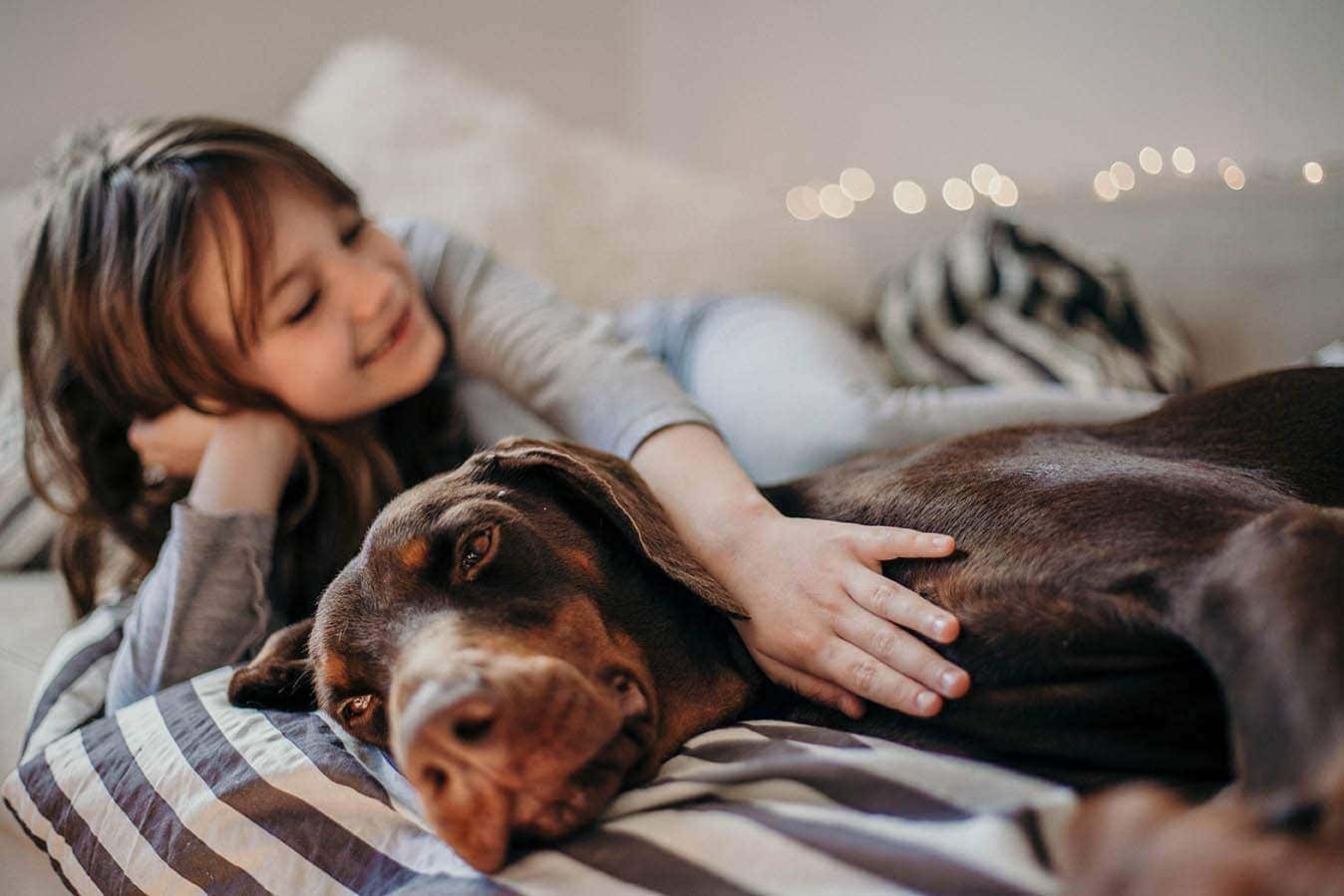
Which Breed Is Right for You?
The most important thing to remember is that every dog is an individual and there is no way of knowing if any dog—regardless of breed—will be right for you and/or your family without meeting and getting to know them a little.
Both German Pinschers and Dobermans are high-energy breeds that make excellent watchdogs and typically enjoy family life. In short, both breeds are fantastic, and both can get along perfectly well with children and other pets if they’ve been well-socialized.
That said, based on our research, it seems that, generally, Dobermans might be slightly better suited to homes with young children than German Pinschers are, though this really depends on the individual dog—we can only ever make generalizations without actually meeting the dog!
If you’re adopting a German Pinscher or Doberman as an adult, ask the shelter or previous owner for information on whether or not they’d be suitable for a home with children and/or other pets.
Featured Image Credit: Top – Dora Zett, Shutterstock | Bottom – Kseniia Kolesnikova, Shutterstock


